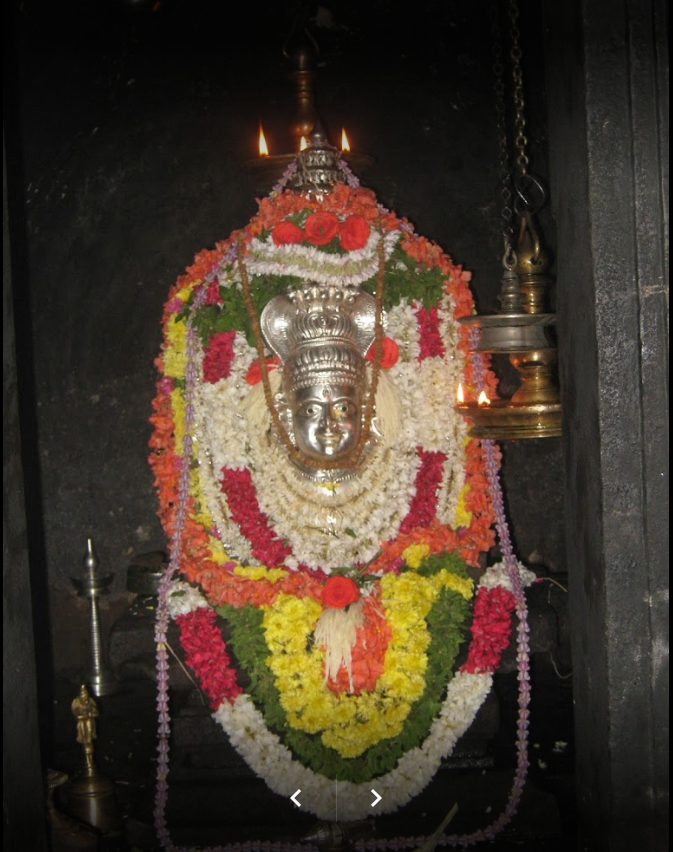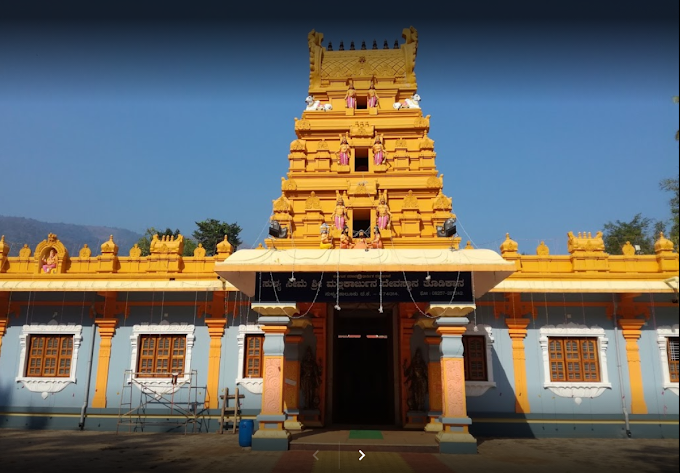Legend and history
The Swarup or divine form of Shrinathji is said to be self-manifested. The deity of the Lord Krishna according to the legend, is self-manifested from stone and emerged from the Govardhan Hills. Historically, the image of Shrinathji was first worshipped at Govardhan hill, near Mathura. The image was initially shifted from Mathura in 1672 A.D. along river Yamuna and was retained at Agra for almost six months, in order to safeguard it from, according to legend, the Mughal ruler Aurangzeb, who wished to keep the prestigious deity with him in Agra. Subsequently, the image was transferred further south on a chariot to a safer place to protect it from barbarian destruction unleashed by Mughal ruler Aurangzeb. When the deity reached the spot at village Sihad or Sinhad, the wheels of bullock cart in which the deity was being transported sank axle-deep in mud and could not be moved any farther. The accompanying priests realised that the particular place was the Lord's chosen spot and accordingly, a temple was built there under the rule and protection of the then Maharana Raj Singh of Mewar. Shrinathji Temple is also known as 'Haveli of Shrinathji’ (mansion). The temple was built by Goswami priests in 1672.
In 1934 a Firman was issued by the Udaipur Darbar, by which, inter alia, it was declared that according to the law of Udaipur all the property dedicated or presented to or otherwise coming to the Deity Shrinathji was property of the shrine, that the Tilkayat Maharaj for the time being was merely a custodian, Manager and Trustee of the said property and that the Udaipur Darbar had absolute right to supervise that the 562 property dedicated to the shrine was used for the legitimate purposes of the shrine.
According to the hagiography of the Pushtimarg, Shrinathji used to travel to Mewar to play chaupar (an antecedent to Parcheesi) with a Princess by the name of Ajab Kunvari. She was upset whenever her beloved Shrinathji would go back to Vraj and asked him to stay with her in the palace. Lord Shrinathji said that one day, when the time was right, he would re-locate to Rajasthan.
Presently, Shrinathji's worship is performed by direct male descendants of Vallabhacharya in a haveli (lit. palatial home) in Nathdwara, Rajasthan.
Economy and livelihoods in Nathdwara town revolve around the Haveli, the term used for the temple probably because it was situated in a fortified mansion, or Haveli, once a royal palace of the Sesodia Rajput rulers of Mewar.
Shrinathji was quite popular with other medieval devotees, as well, as there were preachers who founded Shrinathji temples in present-day Pakistan (Dera Ghazi Khan). This was done by Shri Lal Maharaj ji and his deity of Shri Gopi Nath ji and Shri Dau ji of Dera Ghazi Khan, earlier a part of undivided India and not far from here. Shrinathji was even worshiped as far away as Russia (in the lower Volga region) and other places on the Central Asian trade routes.
The temple has been designed in the lines of Nanda Maharaj (Krishna's father) temple, in Vrindavan. Therefore, it is also known as Nanda Bhavan or Nandalaya (the House of Nanda).
Structurally, a kalasha on the shikhara marks the top of the temple, on which seven flags are flown along with the Sudarshana Chakra. The seven flags represent the 7 'houses' of Pushti Marg or Vallabh Sampradaya. The temple is also popularly called Shrinathji ki Haveli (House of Shrinathji). With the mood of worship in Pushti Marg, Shrinathji is not seen as an impersonal God so the worship is not done like in a temple. Shrinathji is seen as Thakorji or Lord of the House or Haveli and Sewa (service) is offered rather than worship. Like a regular household it has a chariot for movement (In fact the original chariot in which Shrinathji was brought to Singhar), a store room for milk (Doodhghar), a store room for betel (Paanghar), a store room for sugar and sweetmeats (Mishrighar and Pedaghar), a store room for flowers (Phoolghar), a functional kitchen (Rasoighar), a jewellery chamber (Gahnaghar), a treasury (Kharcha bhandaar), a stable for horses of chariot (Ashvashala), a drawing room (Baithak), a gold and silver grinding wheel (Chakki).
The Nathdwara temple has subsidiary temples dedicated to deity Madan Mohan and Naveet Priya, located in the main complex.
Contact
Shrinathji Mandir
Nathdwara, Rajasthan - 313 301
Phone: +91 02953 233484
![]() : https://www.nathdwaratemple.org/
: https://www.nathdwaratemple.org/















